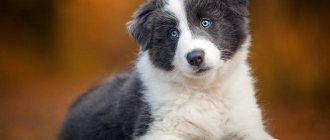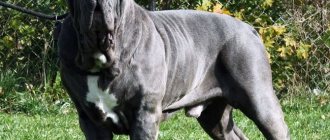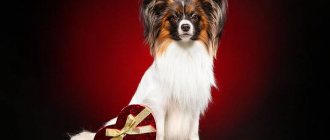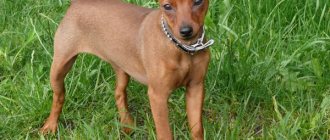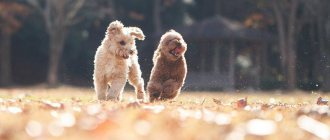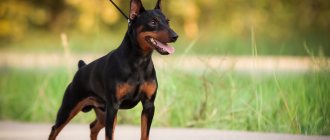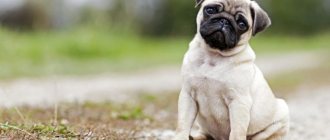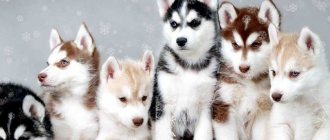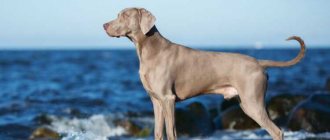The Austrian Pinscher (German: Österreichischer Pinscher, English: Austrian Pinscher) is a medium-sized dog breed from Austria, where dogs of this type were originally dogs that kept rat-free barns and acted as guards and cattle drivers. Not being a purebred until the 20th century, the breed's population plummeted to the point where it was nearly extinct by the 1970s. Serious efforts are currently being made throughout Austria to revive the breed.
Breed Features
Dogs of this breed have good endurance, fearlessness and a strong disposition. They are very active, playful and do not like to sit in one place. The Austrian Pinscher is a truly unique breed. In Austria, these dogs are protected by a local association that protects indigenous breeds from extinction and capture. All this is due to the unique performance characteristics of the animals. There are more than 12 kennels in the country that protect Austrian Pinschers and prevent the breed from declining.
Origin story
This breed was developed around the 18th century. The proof is in the paintings that depict noble people surrounded by these dogs. For quite a long period of time, the standard pinscher was separated from the shorthaired one. Only decades later the subspecies of the breeds were combined into one. Emil Hauk participated in the discovery of these dogs. It was he who, in the 20th century, went on an expedition across the lands of Austria to find the breed. Breeding began in 1921 in their home country.
After some time, the dog breeders' association recognized the Austrian Shorthaired Pinscher breed and announced it to the whole world. Unfortunately, these dogs are not at all popular, except within Austria. Cheerful, active and cheerful dogs of this breed have long won the hearts of local residents, but have not yet gained fame throughout the world.
Even after a huge period of time, modern dog handlers cannot say for sure what breed the Austrian Pinschers came from. In their homeland, many people call them short-haired terriers, so some believe that this breed originated from the German pinscher. Dogs have always been actively used in farming to guard livestock, as well as for hunting small game: rabbits, foxes, etc. They guarded farms and stables. Austrian pinschers have never been decorative. Over the years, the breed developed, and with its help new species were discovered. One of the most popular breeds descended from the Austrian Pinscher is the Doberman Pinscher.
German
German Pinschers are considered the progenitors of all types of Pinschers, since they appeared in Germany back in the 18th century. The exceptions are Austrian and dwarf cats, with whom the “Germans” bred at the same time. It is believed that representatives of this breed descended from swamp dogs that were common in the southwest of the country.
Pinschers have a colossal capacity for work, which allowed them to tirelessly look after the owner’s property and run after carts. They were officially recognized in 1884.
Today, German Pinschers (standard) are not a common breed.
Visually, they are similar to both Doberman Pinschers and Miniature Pinschers, with the exception of size. Their height does not exceed 50 centimeters, weight - 20 kilograms.
The character of German Pinschers is kind, sociable and at the same time serious. Dogs are fanatically devoted to all family members, but they are very persistent and domineering, so they obey only a decisive and firm person. Harsh training methods are not accepted. Walking and physical activity are an integral element of education for them. The main feature of German pinschers is the ability to jump up to 1.5 meters in length.
Breed in the modern world
Now these dogs are considered a rare variety of pinschers, which are separated into a separate branch. It is impossible to describe the Austrian Pinschers breed without mentioning their friendly nature. These are obedient, loyal, intelligent, fearless and brave dogs. They know how to love their owner with all their hearts.
Thanks to the enormous support of local kennels and lovers of this breed, the Austrian Pinscher has retained absolutely all of its original qualities, for which it was famous in ancient times. These dogs have always been one of the most hardy, active and loyal among other guard breeds. It is also important that in addition to their advantages in the working sphere, these dogs have a cheerful and good-natured disposition, making them excellent companions for people. The devotion and kindness in these dogs goes well with their watchdog and security qualities.
Austrian Pinscher training
The breed is an extremely intelligent dog and is likely to be able to learn almost anything that any canine species can learn, with the possible exception of herding or scent-spotting. Farmers for centuries have used this dog for a variety of tasks with great success.
Professional breeders and experienced owners often find these dogs to be very capable and obedient. However, the variety is not always easy to train. Austrian Pinschers tend to be quite dominant and challenge for dominance.
Pets will not willingly obey any owner. Breeders who are unable to maintain a consistent position of dominance will likely end up with an animal that will completely ignore their commands and do only as it pleases.
Appearance of dogs
Looking at the photo of Austrian Shorthaired Pinschers, we can conclude that they belong to the category of medium-sized dogs. The dog's weight ranges from 12 to 18 kg, depending on gender. Bitches weigh less than males and are more compact in size. The height of males varies within 50 cm, and females - 35 cm. The dogs have a very unusual color. It is this that distinguishes them from German pinschers and other working breeds of dogs with similar external characteristics. Austrians can have yellow, auburn or brown coats. Dark colors should always have a reddish tint. The dog may also have a brindle coat with white spots on the paws or chest.
Dogs of this breed have stocky bones and a wide chest. This is the first thing your attention falls on when looking at a photo of an Austrian Pinscher. A description of a breed always begins with the most pronounced parts of the animal's body. The head of Pinschers always looks like a pear. The eyes are very large, expressive and dark in color. The dog's muscles are dry and well defined under the skin. Ears and nose are small. Dog owners can choose to dock them or leave them hanging - any choice will not affect the appearance of the animal.
The tail of the Austrian Pinschers is not long and resembles a ring. It is not docked, but left in this form. The dog's neck is short, strong and muscular. All legs are long. Such breed standards were officially designated in Austria back in 1981. So far, no innovations or changes have occurred in the Austrian Pinscher breed. The photo of an Austrian Pinscher dog presented below only confirms this fact.
How to choose a puppy
There is practically no such breed in Russia. You will have to buy a pet abroad. First of all, you should pay attention to the photo of the dog that is the mother of the puppies. The bitch should look healthy. If her eyes are cloudy, the animal looks too thin, or emaciated, you should not take a puppy from such a dog. The Campbell test will help you choose a good puppy.
Character and temperament
The main character traits of a dog of this breed are considered to be intelligence, activity, liveliness and devotion. They are very attached to their owner and cannot imagine their life without him. As for distrust, they only show it towards strangers. The primary instinct of these dogs is protection. They will always treat strangers with caution, since any stranger to them is a potential offender to their beloved owner.
Austrian Smooth Pinschers are good with children, but will not allow them to hurt themselves during play. Therefore, when leaving a child with this dog, you need to be sure that the child will not offend the animal and indulge in unnecessary behavior. Despite their love for one owner, they will not ignore other family members. These pets love to cuddle, play and have fun with all the people close to them. They will trust everyone who constantly lives and communicates with them. But Austrians will never go to someone who has a negative attitude towards them or the owner.
miniature pinscher
In Germany, miniature pinschers began to be bred at about the same time as the German ones. These babes instantly became popular both in their homeland and abroad. And this fact is explained not only by its attractive exterior, but also by its talent in terms of catching rodents and selflessly protecting the owner’s property. Today they are just adorable dogs that have turned into pets. The first miniature pinscher fan club was opened in 1895 in Germany.
Miniature Pinschers are very temperamental, and their aggression and tendency to fanatically guard their territory sometimes leads to problems. They are unusually active and mobile, it feels like they have a hidden motor inside them that allows them to move continuously. Dogs are quite intelligent and quick-witted, but they are difficult to train and show at shows due to their excitability and excessive energy.
Externally, dwarf pinschers are similar to Dobermans, but have miniature sizes: weight - up to 6 kg, height - up to 30 cm. Colors: red, brown, black and tan.
Dog's habitat
Despite the fact that the dog is of medium size, it is better not to buy it for living in an apartment. Austrian Pinschers are very active, they constantly need space to run around and be pampered. By nature, they are very freedom-loving and without space they quickly begin to lose their positive qualities and performance characteristics. In cramped spaces, they become passive, sad, and in some cases even aggressive. To live a full life in a city apartment, they need to walk and run in the fresh air for at least 5 hours a day. Not everyone can provide such a luxurious walk.
That is why the best place to live for a dog of this breed is considered a country house. Only there will the dog maintain its physical shape and fully demonstrate its instincts. From the photo of the Austrian Pinscher we can safely conclude that it is in the open area that the animal feels happiest. The house must have a wide area so that the dog can walk and run freely without a leash. Only in such conditions will the Austrian develop well and show his best natural characteristics. It is advisable to make an insulated enclosure on the site so that the dog can rest in it without being on a chain. The Austrian Pinscher is an excellent guard, watchman and just a friend who will protect his owner and his home around the clock.
Reviews
Marina (Durnstein, Austria):
“My husband is an ardent fan of the Austrians. For my mother and I, who are accustomed to seeing such dogs in Russia as mongrels (we ourselves have kept miniature schnauzers all our lives), this passion was incomprehensible at first. But after getting to know different representatives of the breed better, my opinion changed. The dogs are small, friendly, get along well with each other, and are very sociable. As a family dog - a very suitable option. I know little about their working qualities; the breed is in the recovery stage. I know that it’s not that difficult to find them on private property or on farms, which means they are in demand among the local population.”
Sources
- https://dogipediya.ru/porody-sobak/srednie/avstrijskij-pincher-foto-i-opisanie-porody
- https://murashdom.ru/porody/avstrijskij-pincher.html
- https://sobakainfo.ru/avstrijskij-korotkosherstnyj-pincher-opisanie-xarakter-foto/
- https://www.ekzotika.com/dogs/avstriyskiy_korotkosherstnyiy_pincher/
- https://tutknow.ru/animals/9339-pravila-uhoda-za-avstriyskim-pincherom.html
- https://usatiki.ru/avstrijskij-pincher/
[collapse]
We recommend reading:
- An enclosure for a dog: how to make a beautiful warm outdoor enclosure with a winter road with your own hands - drawings, sizes, photos, projects, tips on how to build it yourself
- DIY dog house, design of a beautiful large dog house with a veranda, kennel in the apartment
- Caring for a dog's fur: how and what to comb properly, combs for long, short-haired, smooth-haired dogs, how to comb tangles, products - shampoo, spray
- Knitted clothes for small dogs - knitting patterns
Breed content
If a dog of this breed is not trained, it will grow up to be very stubborn and willful. Therefore, anyone who decides to get an Austrian must be prepared for constant training and training of the dog. Its owner must have perseverance and patience. Otherwise, this union will not bring pleasure to either the animal or the person. Only under conditions of strict discipline will an Austrian grow up to be a good watchman and a loyal friend. Buying a dog of this breed is recommended for those who prefer a healthy lifestyle and constant physical activity. You can go jogging and even go hiking with this pet.
Animal training
For dog training to be successful, it is very important to remember that this breed is very receptive to praise. Therefore, this is exactly what needs to be used in daily training as an incentive to carry out all commands. The dog should not be punished, much less beaten. This will only disturb her psyche and will develop aggression and fear that is not typical for this breed. A dog's favorite toy is an ordinary ball. This can be seen from the photo of an Austrian Pinscher on the street. He will happily run after him while playing outdoors.
General characteristics, description
The Shorthaired Pinscher is a compact, medium-sized dog, 42-50 cm high, with short, dense coat that is resistant to various weather conditions.
- The shape of the head is pear-shaped and has significant differences between females and males. The ears are small, hanging or semi-dropping, set high.
- The tail is crescent-shaped or curled into a single ring. The color is varied: fawn, various shades of red, black and tan. White markings on the head, chest and feet are often present and are not considered a fault.
The current FCI standard dates back to 2003. The most significant difference compared to the old FCI standard is the change in name: from “Austrian Shorthaired Pinscher” to “Austrian Pinscher”.
Other changes include raising the minimum height from 35cm to 42cm and recognizing black and tan as the standard coat.
- For unexplained reasons, unfortunately, the liver and black colors, which have always been recognized and widespread, were excluded. It should be noted that black dogs are still born regularly today.
There is no single phenotype in the breed yet; individuals often look different. But it must be remembered that the breed is still in its formation stage.
Dog care
As for the care of representatives of this breed, they require minimal care. You just need to wash your dog when it gets dirty (about once a month), and also comb out excess hair once or twice a week. To comb out, you will need rubber gloves and a slightly wet towel. If you do not rid your pet of excess hair, it will begin to shed too much and spread throughout the area. Cleaning the room from it will be much more difficult than brushing the dog once a week.
We must not forget that these pets are prone to gaining excess weight without proper physical activity. If you are wondering what weight is normal for an Austrian Pinscher puppy, you should consult a veterinarian. He will immediately determine the presence of excess subcutaneous fat and adjust the diet. It is very important to pay attention to the dog’s weight from puppyhood. This way you can prevent possible obesity and the various diseases that it entails.
It is also necessary to carefully monitor your pet's teeth. To prevent this from causing difficulties in the future, you should accustom your dog to brushing while still a puppy. If this moment has been missed, it is necessary to take your little friend to the veterinarian from time to time to remove tartar in the mouth. You can also trim your dog's nails there. The dog owner should carefully monitor the condition of the dog's eyes, nose and ears. Most often, various infections primarily affect the condition of these organs. If any deviations are detected either in the dog’s appearance or in its behavior, you should immediately contact a veterinary clinic.
Doberman
This type of pinscher was bred in the mid-19th century by Friedrich Louis Dobermann, in whose honor the breed got its name. Dobermans are nothing more than an enlarged copy of miniature pinschers. To form the breed, German pinschers, Beaucerons, Rottweilers, as well as some types of hunting dogs were involved. Reached official recognition in 1863.
Dobermans are characterized by a strong physique, which combines strength, grace, and proud posture. These are large dogs, whose weight varies from 35 to 45 kg, height at the withers - from 60 to 70 cm. The coat is short, thick, straight, without undercoat. The standard allows only two colors - black and brown.
Dobermans have a very temperamental character, but they are too smart to show their emotions. These are unusually brave dogs, excellent guards and devoted companions to humans. In case of danger, they always fight back the ill-wisher. They have high intelligence and are easy to train, which allows them to be used for work in government agencies - police, customs.
Dog food
When purchasing a pet of this breed, you must take care in advance to ensure that its nutrition is balanced. In order for the weight of an Austrian Pinscher puppy to increase as it grows, you should feed the animal only fresh and high-quality food. The basis of the diet should be meat. Each serving should be supplemented with fresh vegetables, as well as cereal porridges. In addition, it is necessary to give the puppy vitamins and minerals that will replenish the supply of essential nutrients in his growing body.
Of course, you should consult your doctor before giving supplements to your pet. He will also be able to determine portion sizes and frequency of feeding for a small puppy or adult dog. The baby needs to be fed in smaller portions, but often. An adult dog needs large portions, but two bowls of food per day will be enough for her. It doesn’t matter whether it’s a puppy or an adult dog – food should always be balanced and rich in nutrients. Only a properly selected diet is the key to a dog’s normal growth, health and development.
Diseases of the breed
The dog was bred in pure nature and countryside conditions, so good health is inherent in its genes by nature. This breed has excellent resistance to many diseases and has strong immunity. Austrian Pinschers were bred in harsh conditions back in the 18th century, so they will thrive in any climate. Breeders raise these dogs with minimal deviation from the original characteristics of the breed and do not mutate their genes. Therefore, today's Austrian Pinscher is practically no different from the original dogs of this breed.
However, like any other creature, these dogs get sick. Most often, diseases attack them in old age. Animals are prone to cardiovascular diseases. Heart failure is inherited by these dogs, so it is impossible to eradicate this pathology. The blame for this falls on illiterate breeders who make mistakes when breeding dogs. Also, heart problems can occur in a pet due to improper feeding and a sedentary lifestyle.
In addition, the Austrian is prone to the appearance of demodicosis and cataracts. Without an active lifestyle, dogs develop joint dysplasia. If you properly care for the animal, feed it in a balanced manner and walk it a lot, the dog will live a long and healthy life.
Health
The breed is small in number and not very widespread outside its homeland. Therefore, no special studies were done for certain diseases. Close inbreeding has produced certain results. Most likely, the health of the Austrian pinschers deteriorated because of him.
Diseases
If we draw conclusions about the health of those dogs whose blood is present in this breed, then pinschers from Austria are prone to:
- hip dysplasia;
- cataracts;
- heart diseases;
- autoimmune diseases.
Vaccinations
All vaccinations are standard. The first at the age of 3 weeks, the second at 56 days. Next, the annual complex. It includes vaccination against rabies, plague and infectious diseases.

